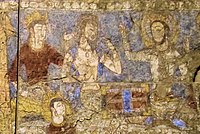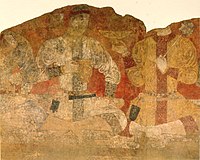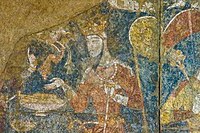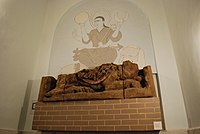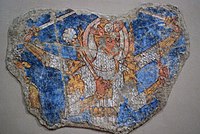Panjakent
Panjakent
Панҷакент Пенджикент | |
|---|---|
From the top to bottom-right, View over Panjakent, Entrance Sign to the City, Panjakent Bazaar, Monument in the City Centre | |
| Coordinates:39°29′12″N67°37′11″E/ 39.486769°N 67.619734°E | |
| Country | |
| Region | Sughd Region |
| Elevation | 996 m (3,268 ft) |
| Population (2020)[2] | |
| • City | 303,000 |
| •Urban | 52,500 |
| Time zone | UTC+5 |
| Official languages | |
 | |
Panjakent(Tajik:Панҷакент) orPenjikent(Russian:Пенджикент[a]) is a city in theSughdprovince ofTajikistanon the riverZeravshan,with a population of 52,500 (2020 estimate). It was once an ancient town inSogdiana.The ruins of the old town are on the outskirts of the modern city. TheSarazm Important Bird Arealies downstream of the city on thetugay-vegetatedfloodplainof the river.
History[edit]
Ancient Panjakent was a small but flourishing town of theSogdiansin pre-Islamic Central Asia. It was known as Panchekanth.[4]It means five towns (villages) inPersian.The ethnic and territorial name "Soghd/Soghdian" or Sughd/Sughdian was mentioned in history as early as the IranianAchaemenid dynasty(6th century BC). The Achaemenids founded several city-states, as well as cities along the ancientSilk Roadand in theZarafshanvalley.

The town grew in the 5th century AD and many professionals such as established businessmen and landowners made their livelihoods in Panjakent. In AD 722,Arab Muslimsforces besieged and took the town. The last ruler of the townDivashtichfled into upper Zarafshan but he was captured and sentenced to death. For around 50 years, ancient Panjakent was ruled by new administrators but towards the end of the 8th century the town on the upper terraces was depopulated and relocated. Many ancient ruins of the old city, particularly the city architecture and works of art remain today.
Numerous records of a Penjikent rulership, written in Sogdian, were located not far of Penjikent on Mount Mug. Through their reading of these texts, the public of Central Asia in the 8th century will judge on social, economic and political life.[5]

According to Arab geographers, Panjakent in the 10th century had a formal Fridaymosquethat distinguished the place as a town from a village. It was the easternmost city of Soghd, and became well known for itswalnuts.[6]
Russian archaeologistBoris Marshakspent more than fifty yearsexcavatingthe ruins at Panjakent.[7]He remained there even after Tajik independence as director of the excavation of the Panjakent ruins, during the years ofCivil War in Tajikistanfrom 1992 to 1997. Through close cooperation with thegovernment of Tajikistan,Marshak ensured the protection and continued excavation of the Panjakent ruins.
Ancient murals and artifacts[edit]
Numerous murals were recovered from the site of Panjikent, and many of them are now on display in theHermitage Museumand in theNational Museum of Antiquities of TajikistaninDushanbe.A great variety influences are visible in the paintings, which show details of dress and daily life: Greek decorative styles encounter the Iranian narratives of theShahnamehand the epic cycle ofRostam,scenes of festivities alternate with depictions of combats, local cults mix with Iranian andHindudeities.Shaivismwas popular in Sogdiana and Eastern Turkestan as found from the wall painting from Penjikent on the river Zervashan. In this depiction,Shivais portrayed with a sacred halo and a sacred thread ( "Yajnopavita" ). He is clad in a tigerskin while his attendants are wearing Sogdian dress. There is a depiction of him four-legged seated cross-legged on a cushioned seat supported by two bulls.
The production of paintings started in the 5th century AD and stopped in 722 AD with the invasion of theAbbasid Caliphate,and many works of art were damaged or destroyed at that time.[8][9]
-
Chinese-style coinage of the rulers of Penjikent, Tajikistan, 7-8th century CE
-
She-wolf suckling two infants ( "Romulus and Remus"), Penjikent, 5th century CE,National Museum of Antiquities of Tajikistan(KP 208–243).[10]
-
]] riding the bullNandi,Penjikent Temple II, 690-722 CE,National Museum of Antiquities of Tajikistan(60).[11]
-
Penjikent, figures with halos,Hermitage Museum
-
Men banquet, pigment on plaster. Pendjikent, Tajikistan
-
Panjikent mural (6th-7th century AD).Hermitage Museum
-
Panjakent (Panjīkant) mural, 6th-8th centuries AD.Hermitage Museum
-
Panjakent (Panjīkant) mural, 6th-8th centuries AD.National Museum of Antiquities of Tajikistan
-
Panjakent (Panjīkant) mural, 6th-8th centuries AD
-
Lion and GoddessAnahita,Penjikent, 6th-8th c AD
-
Multi-armed deity in armour
Geography[edit]
Climate[edit]
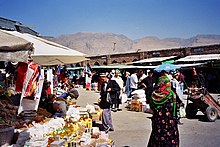
Panjakent has ahot summer humid continental climate(Köppen climate classificationDsa). The average annual temperature is 10.7 °C (51.3 °F). The warmest month is July with an average temperature of 22.8 °C (73 °F) and the coolest month is January with an average temperature of −1.6 °C (29.1 °F). The average annual precipitation is 468.5 mm (18.4 ") and has an average of 87.9 days with precipitation. The wettest month is April with an average of 94 mm (3.7" ) of precipitation and the driest month is August with an average of 2.6 mm (0.1 ") of precipitation.[1]
| Climate data for Panjakent (Pendzikent-38705) | |||||||||||||
|---|---|---|---|---|---|---|---|---|---|---|---|---|---|
| Month | Jan | Feb | Mar | Apr | May | Jun | Jul | Aug | Sep | Oct | Nov | Dec | Year |
| Daily mean °C (°F) | −1.6 (29.1) |
−0.4 (31.3) |
4.9 (40.8) |
11.2 (52.2) |
15.6 (60.1) |
20.5 (68.9) |
22.8 (73.0) |
21.1 (70.0) |
16.4 (61.5) |
10.4 (50.7) |
5.5 (41.9) |
1.4 (34.5) |
10.7 (51.3) |
| Averageprecipitationmm (inches) | 53.0 (2.09) |
53.2 (2.09) |
85.0 (3.35) |
94.0 (3.70) |
62.6 (2.46) |
11.1 (0.44) |
6.0 (0.24) |
2.6 (0.10) |
4.6 (0.18) |
31.8 (1.25) |
33.9 (1.33) |
48.7 (1.92) |
468.5 (18.44) |
| Average precipitation days(≥ 0.1 mm) | 10.7 | 11.3 | 13.5 | 12.1 | 9.3 | 3.1 | 2.3 | 1.2 | 1.7 | 5.6 | 7.5 | 9.6 | 87.9 |
| Averagerelative humidity(%) | 66.1 | 66.9 | 64.4 | 60.9 | 53.8 | 42.3 | 41.3 | 42.1 | 45.3 | 55.1 | 59.1 | 64.4 | 55.1 |
| Source:"The Climate of Panjakent".Weatherbase.Retrieved7 August2014. | |||||||||||||
Subdivisions[edit]
Before ca. 2018, Panjakent was the seat ofPanjakent District,which covered the rural part of the present city of Panjakent.[12]The city of Panjakent covers Panjakent proper and fourteenjamoats.[2]These are as follows:[13]
| Jamoat | Population (Jan. 2015)[13] |
|---|---|
| Amondara | 13,380 |
| Chinor | 6,879 |
| Farob | 8,650 |
| Khalifa Hassan | 14,728 |
| Khurmi | 10,451 |
| Kosatarosh | 18,986 |
| Loiq Sherali | 18,675 |
| Moghiyon | 19,553 |
| Rudaki | 18,465 |
| Sarazm | 27,877 |
| Shing | 10,873 |
| Sujina | 12,285 |
| Voru | 12,347 |
| Yori | 19,045 |
Notable people[edit]
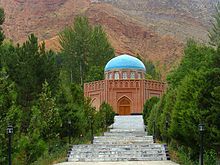
- Nigina Amonkulova,folk singer[14]
- Khayrinisso Yusufi,vice-premier of Tajikistan, member of theAssembly of Representatives.[15]
- Otakhon Latifi(Tajik:Отахон Латифи)(1936–1998), was a noted journalist and politician[16]
- Yaqub Beg,leader of Uighur state ofYettisharduring theDungan Revoltagainst theQing dynastyin years 1865–1877[17][circular reference]
- Rustem Umierov(b. 1982), Ukrainian Crimean Tatar politician
See also[edit]
Notes[edit]
- ^Also spelled or romanized asPendzhikent,Penjikent,Panjekent,Panjikent,etc.
References[edit]
- ^ab"Climate of Panjakent".Weatherbase.Archivedfrom the original on 8 August 2014.Retrieved7 August2014.
- ^ab"Population of the Republic of Tajikistan as of 1 January 2020"(PDF)(in Russian). Statistics office of Tajikistan. Archived fromthe original(PDF)on 1 June 2021.Retrieved3 October2020.
- ^"КОНСТИТУЦИЯ РЕСПУБЛИКИ ТАДЖИКИСТАН".prokuratura.tj.Parliament of Tajikistan.Retrieved9 January2020.
- ^Gorgâni, Tirdâd."Welcome to Penjakent".GEOCITIES. Archived fromthe originalon 2009-07-28.RetrievedJuly 23,2008.
- ^"Panjikent".RetrievedMarch 30,2021.
- ^Marshak, B.I."Panjikant".Encyclopædia Iranica.Archivedfrom the original on 2015-11-16.Retrieved2011-08-08.
- ^Shkoda, V. (October 2003)."Marshak's Bibliography and CV".Transoxiana Webfestschrift Series I.Transoxiana: Journal Libre de Estudios Orientales.Archivedfrom the original on 2007-01-01.Retrieved2006-10-14.
- ^"PANJIKANT – Encyclopaedia Iranica".iranicaonline.org.
- ^Compareti, Matteo (2012)."Classical elements in Sogdian art: Aesop's fables represented in the mural paintings at Penjikent".Iranica Antiqua.XLVII:303–316.
- ^[978-9461616272Tadjikistan: au pays des fleuves d'or]. Paris, Gand: Musée Guimet, Snoek. 2021. p. 133.ISBN978-94-6161-627-2.
{{cite book}}:Check|url=value (help) - ^[978-9461616272Tadjikistan: au pays des fleuves d'or]. Paris, Gand: Musée Guimet, Snoek. 2021. p. 164.ISBN978-94-6161-627-2.
{{cite book}}:Check|url=value (help) - ^"Population of the Republic of Tajikistan as of 1 January 2015"(PDF)(in Russian). Statistics office of Tajikistan. Archived fromthe original(PDF)on 2 July 2015.Retrieved3 October2020.
- ^abJamoat-level basic indicators,United Nations Development Programme in Tajikistan, accessed 3 October 2020
- ^"Nigina Amonkulova (Amonqulova)".life.ansor.info.Retrieved2020-12-17.
- ^Kamoludin Abdullaev; Shahram Akbarzaheh (27 April 2010).Historical Dictionary of Tajikistan.Scarecrow Press.ISBN978-0-8108-7379-7.Archivedfrom the original on 31 May 2014.Retrieved15 September2017.
- ^"Opposition-Chief-Dies".Associated Press.Archivedfrom the original on 2018-01-03.Retrieved2018-01-02.
- ^"Yaqub Beg".
External links[edit]
 Panjakenttravel guide from Wikivoyage
Panjakenttravel guide from Wikivoyage







![She-wolf suckling two infants ("Romulus and Remus"), Penjikent, 5th century CE, National Museum of Antiquities of Tajikistan (KP 208–243).[10]](https://upload.wikimedia.org/wikipedia/commons/thumb/6/6e/Bracteate_she-wolf_NMAT_KP208-243_%28cropped%29.jpg/200px-Bracteate_she-wolf_NMAT_KP208-243_%28cropped%29.jpg)
![]] riding the bull Nandi, Penjikent Temple II, 690-722 CE, National Museum of Antiquities of Tajikistan (60).[11]](https://upload.wikimedia.org/wikipedia/commons/thumb/5/5b/Uma-Maheshvara%2C_Shiva_with_spouse_Uma_riding_the_bull_Nandi%2C_Penjikent_Temple_II%2C_690-722_CE%2C_Tajikistan_National_Museum_of_Antiquities_%2860%29.jpg/200px-Uma-Maheshvara%2C_Shiva_with_spouse_Uma_riding_the_bull_Nandi%2C_Penjikent_Temple_II%2C_690-722_CE%2C_Tajikistan_National_Museum_of_Antiquities_%2860%29.jpg)
